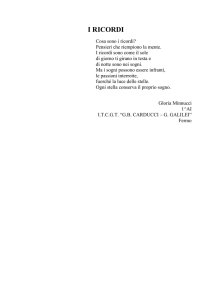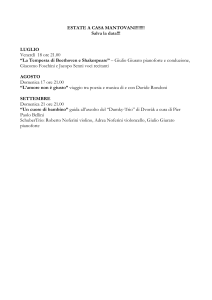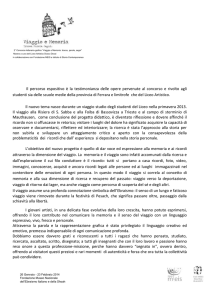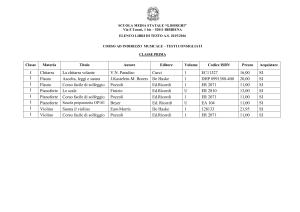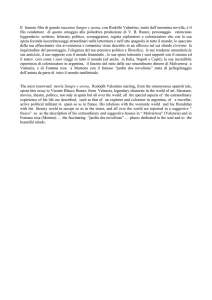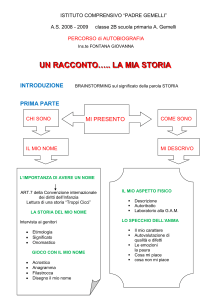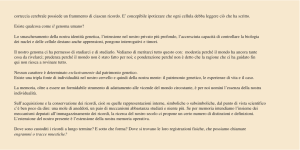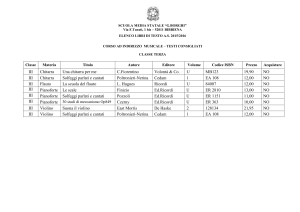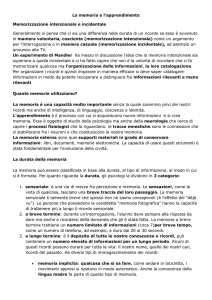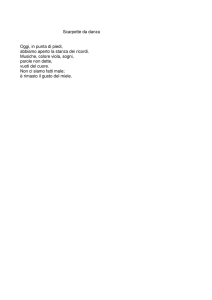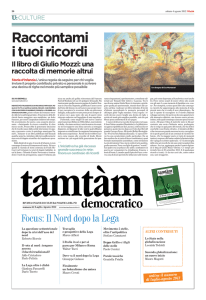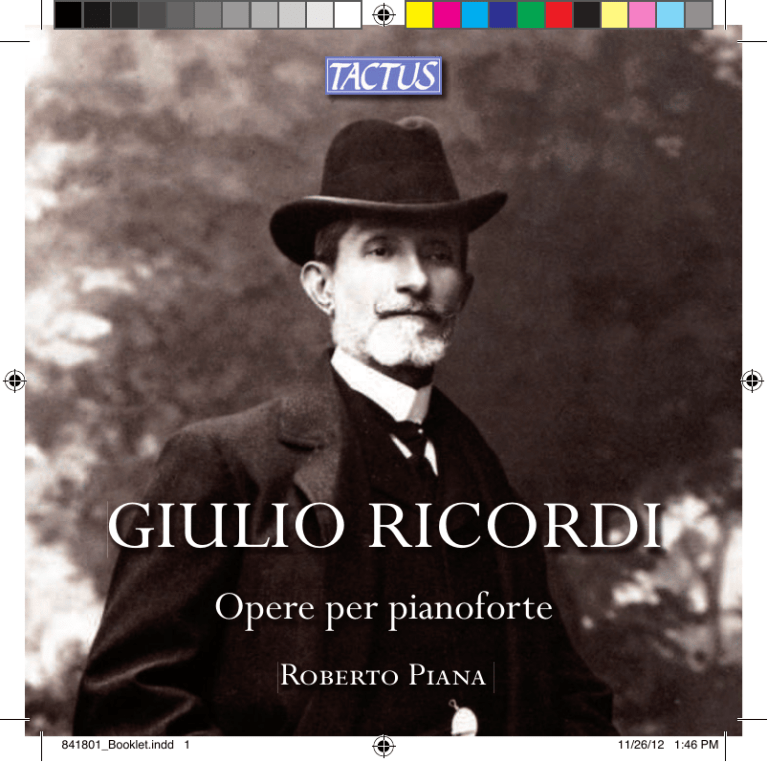
GIULIO RICORDI
Opere per pianoforte
Roberto Piana
841801_Booklet.indd 1
11/26/12 1:46 PM
Tactus
Termine latino con cui, in epoca rinascimentale, si indicava quella che oggi è detta battuta.
The Renaissance Latin term for what is now called a measure.
℗ 2013
Tactus s.a.s. di Seraino Rossi & C.
www.tactus.it
In copertina / on the cover:
Giulio Ricordi, foto d’epoca / vintage photo.
1a Edizione 2013
24 bit digital recording
Editing: Lucio Matarazzo, mastering: Alberto Erre
English translations: Marta Innocenti
Computer design: Tactus
L’editore è a disposizione degli aventi diritto.
841801_Booklet.indd 2
11/26/12 1:46 PM
Un uomo e la sua musica, cent’anni dopo. Note ammalianti e presaghe, a volte sospese, altre irruenti e
guerriere, piene di echi e pure originali, salottiere e sognanti, ‘giardino di delizie’ per il loro autore, preso
dai mille gorghi quotidiani di una Milano ogni giorno più grande.
Un secolo ci separa dalla morte di Giulio Ricordi, il piú geniale editore musicale della storia, nato
nel Risorgimento - era il 1840 - e morto il 6 giugno 1912, sul inire della Belle époque, immerso nella
Scapigliatura e lambito dal wagnerismo, devoto a Verdi e afascinato dal giovane Puccini. Un uomo
complesso, dalla sfaccettata psicologia, arguto e pungente nei suoi scritti giornalistici in Musica e Musicisti,
poi diventata Ars et Labor, rivista della casa sfacciatamente di parte (ma come può esserlo un tifoso guidato
dal cuore), capitano d’industria intransigente e dominatore, conversatore brillante nei salotti (quasi sempre
in puro dialetto milanese), pittore dilettante d’acquerello durante le sue puntate a Barasso, nel Varesotto,
dove viveva la iglia Ginetta, sposata al nobile Origoni. E musicista. Anzi, a sentir Verdi, «l’unico tra i
giovani a sapere veramente la musica». Negli ultimi decenni di vita, quasi ogni sera, Giulio, smessi i ‘panni
curiali’, sedeva al pianoforte e componeva, utilizzando la scrittura musicale quasi come terapia, una sorta di
‘svuotatasche’ del cervello in cui rimanevano intrappolate note di questo o quell’autore, e quasi da sole si
ricomponevano poi come in un caleidoscopio, formando deliziosi quadri d’insieme.
All’inizio, nel fuoco dei vent’anni, quando Giulio partì volontario con i bersaglieri del generale Cialdini,
per il quale la sera suonava al pianoforte Rossini e Verdi, il compositore indugiava su polke – nel suo
curriculum musicale ce n’è perino una Trigonometrica - e galop, ballabili d’occasione e marcette militari, né
si fece mancare un Trio per violino, violoncello e pianoforte (1861), e due Quartetti per archi, il secondo
dei quali, in sol maggiore, fu premiato come secondo dalla Società del Quartetto di Firenze, dopo quello di
Antonio Bazzini, futuro maestro di Alfredo Catalani. In quei tempi beati per la musica, parte, con le belle
lettere e le arti, dell’educazione del «giovin signore» e di fanciulle da marito dotate per il canto, quando
le attese erano per una nuova opera alla Scala e ci si scannava verbalmente sulle gazzette per questo o
quell’autore, Ricordi da buon commerciante, si mise anche a trascrivere pezzi d’opera che, come i dischi
qualche anno dopo, facevano arrivare nelle case le arie piú note mettendole alla portata di (quasi) tutte le
dita. Nel catalogo integrale delle opere, pubblicato nel numero di Ars et Labor del luglio 1912, «In memoria
del suo direttore Giulio Ricordi», si incontrano curiosità quali Le Rimembranze della villa Giuseppina sul Lario,
serenata di Schubert trascritta per due violini con pianoforte, la ‘polka schnell’ L’orologio di Luigi Arditi
(quello del Bacio, cavallo di battaglia dei virtuosi di ischio ai primi del ‘900), accanto ad austere versioni di
Vespri siciliani, Lucrezia Borgia, Re di Lahore e Gioconda.
Roberto Piana, pianista curioso, capace di trasformarsi in archeologo alla ricerca del pezzo raro, si è
1
841801_Booklet.indd 1
11/26/12 1:46 PM
imbattuto in un volumetto Ricordi ormai introvabile, una raccolta di spartiti di un certo Jules Burgmein
curata da Giancarlo Cardini, pianista amico di John Cage, come lui curioso del mondo, che negli anni ’80
aveva anche inciso questi brani in un vinile, dal titolo Il salotto di Giulio Ricordi. Troppo facile il memento
manzoniano: Burgmein, chi era costui? Un francese? Dal nome potrebbe sembrare. Un tedesco? Il cognome
signiica letteralmente «paese mio», quindi almeno un germanoilo? Niente di tutto questo, perché il paese
in questione è l’Italia e Jules altri non è che Ricordi Giulio, nato a Milano e meneghino dalla radice dei
capelli alla punta dei piedi, propugnatore della melodia spiegata e del belcanto, diventato suo malgrado
editore italiano di Wagner, dopo la fusione con la Casa Musicale Lucca di Giovannina Strazza, avvenuta,
auspice Giuseppe Verdi, il 30 maggio 1888. Ma già sul inire degli anni Settanta dell’Ottocento, il Giulio
irmava ogni sua composizione con il curioso pseudonimo, tant’è che nel numero 1, datato 15 gennaio
1902, dell’anno primo di Musica e Musicisti, di cui era direttore, auto alimentava il mistero a pagina 25,
col pubblicare una sua fotograia di spalle, con pastrano, bombetta e bastone da passeggio. Il breve testo
a lato dell’immagine recita: «Chi è J. Burgmein? Dove, quando è nato? Non lo sappiamo, ed inutilmente
abbiamo indirizzato lettere sopra lettere al sig. J. Burgmein: nessuna risposta. Tuttavia, grazie all’abilissimo
fotografo, la cui collaborazione diremo così istantanea venne assicurata al nostro giornale, abbiamo potuto
procurarci la fotograia di questo compositore, del quale annunciamo in questo numero un nuovissimo
Album: Il racconto della nonna». Seguiva la pubblicazione dello spartito del terzo dei sette pezzi dell’album in
questione, intitolato Le Ondine, e il pensiero corre subito al povero Catalani - malvisto in Casa Ricordi ino
alla Wally, perché a torto tacciato di wagnerismo dal nume Verdi e poi transfuga e protetto di Giovannina
Strazza - e alla sua fantasmagorica Danza delle ondine.
Ironia e autoironia, un musicista che come un’ape laboriosa va di iore in iore, ne cattura l’essenza e la
sviluppa secondo il suo personale gusto e piacere, curando maniacalmente le proprie edizioni grazie alle
‘bocche di fuoco’ del suo uicio graico, che contava le matite di Hohenstein, Edel, Laskof, Metlicovitz,
Terzi, Beltrame (autore delle immortali copertine de La Domenica del Corriere) e del giovane Dudovich.
Edizioni che oggi sono la delizia dei collezionisti di graica Art Nouveau, grazie alle immaginiiche
copertine, ai fregi e alle illustrazioni interne a corredo degli spartiti, dedicati spesso a nobildonne dal
croccante cognome d’Oltralpe, cui si univano qualche volta poesie di autori amati, su tutti Paul Solanges,
ex uiciale dei Cacciatori a cavallo e traduttore francese del libretto del Falstaf verdiano assieme allo stesso
Boito.
Curioso com’era, Jules Burgmein guatava ogni cosa accadesse al di fuori del blindatissimo studio di
via degli Omenoni - dove l’usciere Gervasini aveva issato sulla porta la targhetta ammonitrice «Nessuno
2
841801_Booklet.indd 2
11/26/12 1:46 PM
entra senza essere annunciato» - così non gli sfuggivano le possibilità musicali riguardo le invenzioni del
momento: la bicicletta, il tramway, perino l’automobile cui dedicava, ‘pronta consegna’, valzerini, polke e
galop sul modello di Romualdo Marenco, che con il suo gran ballo Excelsior aveva dato luce alla modernità.
Con lo spartito si vendevano, con un piccolo sovrapprezzo, campanelli (per La bicicletta se ne forniva uno
con tappo di sughero sagomato da applicare al portacandele del pianoforte verticale) e altri aggeggi che il
pianista indossava al polso per dar l’idea dei rumori del viaggio, che terminava immancabilmente con una
catastrofe.
Ma le pagine migliori di Giulio Ricordi compositore sono quelle meditate e sapienti della sua ultima
stagione, i bozzetti e i fogli d’album, poesia visiva allo stato puro, piccoli squarci di passato nella costruzione
solida del presente, narrazioni per spunti tematici e impressioni, su cui aleggia un velo di spleen quasi
gozzaniano.In questo milieu del Burgmein più europeo, che guardava ai francesi e alla lezione di Robert
Schumann, ha saggiamente pescato Roberto Piana, incominciando con quel breve capolavoro che è Romance
Poudrée, tratta da Impressions de route, quatre petites pièces pour piano, pubblicati nel 1898 con sontuose tavole
di Leopoldo Metlicovitz e dedica «A madame Elvira Fochessati», madre dello scrittore Guido da Verona.
Già alle prime note evapora un mondo, si percepiscono i larghi cappelli piumati delle dame, il lento
incedere della carrozza, il paesaggio primaverile colmo di iori e olezzi serotini, l’immagine del viaggio
rammemorato poi nel salotto accogliente di una villa patrizia, con la polvere del tempo che lentamente
si adagia sulle cose. Incontriamo in seguito un piccolo manifesto della musica a programma, quel Racconto
della nonna così ben pubblicizzato nel primo numero di Musica e Musicisti: «Si può considerare una vera iaba
in sette pezzi per pianoforte, che lo squisito Burgmein ha musicato su caratteristici versi di Fram». Lo
spartito, del 1900, è un vero capo d’opera, illustrato nel pieno gusto liberty da Achille Beltrame e Leopoldo
Metlicovitz e dedicato alla donna più bella di Milano a quel tempo, Carla Visconti di Modrone Erba, madre
di Luchino e nota per gli abiti leggendari con cui arrivava alle prime della Scala, nonché parente dei Ricordi,
perché sua madre, Anna Brivio, era sorella della moglie di Giulio, Giuditta.
La musica, come scrive Antonio Rostagno, «è assai semplice, eppure è chiara l’intenzione narrativa
realizzata con l’episodica ricorrenza del tema iniziale», e il mondo evocato da Burgmein è quello della
villeggiatura estiva (magari a villa Erba di Cernobbio), con i bambini vestiti di bianco e azzurro a rincorrersi
tra siepi di bosso vista lago e la nonna che li chiama a raccolta per la iaba, all’ora del tè con i pasticcini.
Ci sono tutti gli ingredienti per incantare ascoltatori piccoli e grandi: delicatezza di forma e accensioni
improvvise (ne Il drago), melodie sognanti fatte di due note (Le ondine) e piccoli divertissement (Le lucciolette),
ma Ricordi Burgmein sapeva anche virilmente comporre alla maniera di Liszt e Brahms, come dimostra
3
841801_Booklet.indd 3
11/26/12 1:46 PM
la Fantaisie Hongroise, del 1883, ove si diverte ad anagrammare addirittura il suo pseudonimo, che diventa
un magiaro Grubmeni, e la diicoltà della scrittura pianistica fa onore al padre Tito, dedicatario del pezzo,
ottimo virtuoso e accompagnatore in gioventù della Malibran e della Pasta. Brano di maniera, ma sprizzante
energia, pieno di fulmini e saette e con inale a efetto, come richiesto dal gusto del pubblico d’allora.
Carattere del tutto opposto hanno i successivi Aquarelles e Le rêve de l’Odalisque, lavorati di ino i primi,
con richiami alla Francia di Fauré e Bizet ma anche ai ritrovi proustiani allietati dalle note e dalla voce di
Reynaldo Hahn (ospite del salotto di Giuditta Ricordi era spesso lo scrittore Luigi Gualdo, gentiluomo
amico del conte Robert de Montesquiou-Fézensac, il barone Charlus della ‘Recherche’), debitrice al gusto
orientaleggiante, in voga già agli inizi della Belle époque, la seconda, composta nel 1885. La moda culminerà,
in Jules Burgmein, con la composizione dell’operetta Tapis d’Orient del 1911 e a tutt’oggi mai allestita,
ultimo sforzo dopo il successo della Secchia rapita, su libretto dell’amico Renato Simoni, rappresentata
a Torino l’anno precedente dalla compagnia della diva Gea della Garisenda, poi moglie dell’industriale
Borsalino.
Il pianoforte di Roberto Piana ci porta inine a esplorare i dodici mesi dell’anno, attraverso le brevissime
composizioni dell’Almanacco della Gazzetta Musicale di Milano per il 1885, dedicate al maestro Vincenzo
Appiani e raccolte in uno splendido cadeau tipograico, con illustrazioni di Alfredo Montalti e versi dello
scapigliato Ferdinando Fontana, premio ai lettori del Pungolo. Anche qui musica a programma, con titoli
fantasiosi per ogni mese – gennaio Gli esquimesi, aprile Amore!, novembre Abbandono e così via – e gusto per
la miniatura saporita, lo stesso che portava Burgmein a pubblicare in ogni numero dicembrino di Musica
e Musicisti un brano natalizio con dedica ai bambini, quasi sempre a quattro mani, da suonare davanti al
presepe.
E il Quasi valzer che aianca il nome dell’ultimo mese dell’anno, dà spunto a Fontana di chiosare
simpaticamente, rivolto al fruitore del prezioso libretto: «E a te sempre sorrida l’allegra nota estrema/ che
dà Dicembre all’anno, o benigno lettore; te l’auguran poeta, musicista e pittore».
Anche noi facciamo lo stesso con chi ascolterà queste note del passato, specchio di un mondo estetizzante
e profumato, di lì a poco spazzato via dalla guerra, fatto di sentimenti delicati e gentili, con la musica
parte insostituibile del ménage quotidiano, fonte incessante di piacere e curiosità. E Jules Burgmein,
acuto psicologo del gusto, oltre che musicista rainato e poliedrico, molto spesso, nel trovare le delicate,
acquerellate melodie dei suoi coriandoli sonori, avrà sorriso sotto i bai, pregustando il luccichio d’occhi
d’una fanciulla o il visetto stupito di un bimbo al cantare lieto del pianoforte.
Mario Chiodetti
4
841801_Booklet.indd 4
11/26/12 1:46 PM
A man and his music, a hundred years later. Bewitching, prescient notes, sometimes suspended, sometimes
vehement and combative, full of echoes yet original, worldly and dreamy, “garden of delights” for their author,
who is caught in the manifold daily maelstroms of a rapidly growing city, Milan.
Precisely a century separates us from the death of Giulio Ricordi, the most gifted musical publisher of all
time, who was born in 1840 during the Risorgimento and died on 6 June 1912 when the Belle Époque was
ending; who plunged into the Scapigliatura, came close to Wagnerism, worshipped Verdi and was fascinated by
young Puccini. A complex man, with a multifaceted psychology: he was witty and stinging in his journalistic
writings in Musica e Musicisti, later called Ars et Labor, his publishing house’s magazine (unashamedly partisan,
but with the candour of an emotion-driven gang of fans); he was an inflexible, domineering tycoon, a dazzling
talker in drawing-rooms (almost always in pure Milanese dialect), an amateur water-colour painter during his
stays at Barasso, near Varese, in the house of his daughter Ginetta, who had married a nobleman, Origoni. And
a musician. Actually, in Verdi’s opinion, he was “the only one among the young people to be really well-versed
in music”. During the last decades of his life, almost every evening, Giulio shed his role of “important person”,
sat down at the piano and composed, using music almost as a therapy, as a sort of receptacle for emptying out
his brain, where notes by various composers lingered and eventually agglomerated almost by themselves, as in
a kaleidoscope, creating delightful new patterns.
At the beginning, when Giulio, in his fiery twenties, joined General Cialdini’s bersaglieri as a volunteer
and was in the habit of playing Rossini and Verdi on the piano for the General in the evening, he had a special
preference for composing polkas (including even a Polca Trigonometrica), galops, dance music for special
occasions and military marches. He also composed a trio for violin, cello and piano (1861), and two string
quartets, of which the second, in G major, was awarded the second prize by the Società del Quartetto of
Florence (while the first prize went to Antonio Bazzini, future teacher of Alfredo Catalani).
In those happy times for music (when music, together with letters and art, was a part of the education of
young gentlemen and talented marriageable young ladies, when the highest expectations were for a new opera
at La Scala, and violent verbal clashes took place on gazettes about this or that composer), Ricordi, being a
shrewd merchant, began to transcribe opera pieces, which, like records a few years later, brought the most
famous arias into people’s houses, within the reach of (almost) all performers.
The complete catalogue of his works, published in the July 1912 issue of Ars et Labor, “in memory of its editor
in chief Giulio Ricordi”, contains curious pieces such as Le Rimembranze della villa Giuseppina sul Lario, a serenade
by Schubert transcribed for two violins and piano; the “polka schnell” of L’orologio, by Luigi Arditi (composer
of Il Bacio, the favourite piece of whistling virtuosos at the beginning of the 20th century); and some austere
versions of Vespri siciliani, Lucrezia Borgia, Re di Lahore and Gioconda.
Roberto Piana, an enterprising pianist who is capable of turning into an archaeologist in quest of a rare
5
841801_Booklet.indd 5
11/26/12 1:46 PM
piece, has come across an unobtainable Ricordi booklet: a collection of scores by a certain Jules Burgmein,
edited by Giancarlo Cardini, a pianist who was a friend of John Cage’s, was as curious as him, and in the
nineteen-eighties had recorded these pieces in a vinyl record entitled Il salotto di Giulio Ricordi. As Manzoni
would have said: Burgmein, who was he? A Frenchman? His name seems to suggest it. A German? His surname
seems to connote local pride, so at least he was a Germanophile? Not at all! The composer was Italian, and
Jules Burgmein was none other than Giulio Ricordi, who was born in Milan and was a Milanese down to the
innermost depths of his soul; who was a champion of lusty melodies and bel canto, and the reluctant publisher
of Wagner in Italy (he had to accept this when his publishing house merged with Giovannina Strazza’s Casa
Musicale Lucca, on 30 May 1888, under the auspices of Giuseppe Verdi). Towards the end of the eighteenseventies, Giulio had already started signing all his compositions with this odd pseudonym. In the first issue,
dated 15 January 1902, of the first year of the magazine Musica e Musicisti, of which he was editor in chief,
on page 25, he actually fuelled the readers’ curiosity by publishing a photograph of himself seen from the
back, with overcoat, bowler hat and walking stick. Next to this photograph there was a short text: “Who
is J. Burgmein? Where, when was he born? We don’t know, and have plied him with letters, to no avail: he
doesn’t reply. However, thanks to the fact that our magazine has secured the collaboration of a very nimble,
adroit photographer, we have managed to catch an image of this composer, who, we announce in this issue,
has published a new album: Il racconto della nonna.” The photograph was followed by the score of the third of
the seven pieces of the new album, entitled Le Ondine. This title reminds us of the phantasmagorical Danza
delle ondine by poor Catalani, who was disliked in Casa Ricordi until he composed the opera Wally, because
the adored Verdi accused him, undeservedly, of being a supporter of Wagner’s and later a deserter and protégé
of Giovannina Strazza’s.
Mockery and self-mockery: a musician who flitted like a busy bee from flower to flower, capturing the
essence of each and developing it according to his own taste and pleasure. His publications were obsessively
perfected by him, thanks to the collaboration of the wonderful art editors in his publishing house: among them
there were artists such as Hohenstein, Edel, Laskoff, Metlicovitz, Terzi, Beltrame (author of the immortal
covers of La Domenica del Corriere) and Dudovich, who was then quite young. These editions are now highly
prized by collectors of Art Nouveau graphics, because of their luscious, fantastic covers and the flourishes
and illustrations that accompanied the scores. The pieces were often dedicated to noblewomen with crunchysounding northern surnames and sometimes enriched with poems by beloved authors, particularly Paul
Solanges, formerly officer of the Cacciatori a cavallo and French translator of the libretto of Verdi’s Falstaff in
collaboration with Boito.
Inquisitive as he was, Jules Burgmein was aware of any development outside his strictly guarded office in
Via degli Omenoni (where the porter Gervasini had attached to the door a cautionary plate with the words
6
841801_Booklet.indd 6
11/26/12 1:46 PM
“Nobody comes in without being announced”). So he did not fail to spot the musical possibilities offered by
current inventions such as bicycles, tramcars and even automobiles, and promptly made them the subject of
little waltzes, polkas and galops, taking as his model Romualdo Marenco, who had brightened up the modern
age with his Ballo Excelsior. With a small extra charge it was possible to buy, in addition to the score, some little
bells (with La bicicletta a bell was supplied that had a specially shaped cork lid to be applied to the candle holder
of an upright piano), or other gimmicks that the pianist could wear on his or her wrists in order to re-create
the noises of the journey. The latter unfailingly ended in a catastrophe.
But Giulio Ricordi’s best works are the carefully thought out, masterly pieces of his last season: sketches,
album sheets, pure visual poetry, little glimpses of the past in the firm structure of the present, and stories
based on themes and impressions, in which an aura of almost Gozzano-like melancholy can be perceived.
It is in this sector of Burgmein’s work, where he shows his most Europe-oriented side and is influenced by the
French composers and the lesson of Robert Schumann, that Roberto Piana has wisely carried out his research,
finding, first of all, a short masterpiece, Romance Poudrée, drawn from Impressions de route, quatre petites pièces pour
piano, published in 1898 with sumptuous plates by Leopoldo Metlicovitz and the dedication “A madame Elvira
Fochessati”, mother of the writer Guido da Verona. From the very first notes, a whole world transpires, and we
can perceive the ladies’ broad plumed hats, the slow progress of the carriage, the springtime landscape, rich in
flowers and evening fragrances, and the image of the journey recalled later in the pleasant drawing room of an
aristocratic villa, while the dust of time slowly settles on everything. This piece is followed by a small manifesto
of programme music, precisely the Racconto della nonna that had been so cleverly advertised in the first issue of
Musica e Musicisti: “It may actually be regarded as a fairy tale formed of seven piano pieces, in which the refined
Burgmein has set to music some typical lines by Fram”. The score, published in 1900, is a real masterpiece; its
Liberty-style illustrations are by Achille Beltrame and Leopoldo Metlicovitz, and it is dedicated to the most
beautiful woman in Milan at that time, Carla Visconti di Modrone Erba, mother of Luchino: she was famous
for the fabulous dresses she wore at the premieres of La Scala, and was also a relative of the Ricordi family,
because her mother, Anna Brivio, was the sister of Giulio’s wife Giuditta.
The music, as Antonio Rostagno writes, “is quite simple, but the narrative intention is made clear by the
intermittent reappearance of the initial theme”. The world evoked by Burgmein is that of summer holidays
(maybe at Villa Erba in Cernobbio): the children, dressed in white-and-blue, are chasing each other between
the box hedges with the view of the lake in the background, while their grandmother calls them for her
storytelling and tea with cakes. Everything is designed to charm listeners of all ages: delicate forms, sudden
flares (in Il drago), dreamy two-note melodies (Le ondine), and little divertissements (Le lucciolette). But
Ricordi/Burgmein could also compose fully-fledged pieces in the style of Liszt and Brahms, as he showed in
his Fantaisie Hongroise (1883): here he whimsically used an anagram of his pseudonym, which became a faux
7
841801_Booklet.indd 7
11/26/12 1:46 PM
Magyar surname, Grubmeni, and the complexity of the piano writing was a homage to the dedicatee of the
piece, his father Tito, a virtuoso pianist who during his youth had accompanied singers such as Malibran and
Pasta. The style of this piece is mannered, but it is bursting with energy, full of flashes and thunderbolts, and
has a striking finale, as required by the taste of the public of that period.
The next two pieces, Aquarelles and Le rêve de l’Odalisque, have completely different characteristics. Aquarelles
is finely crafted and evokes the France of Fauré and Bizet, and also the Proustian gatherings enlivened by the
notes and voice of Reynaldo Hahn (Giuditta Ricordi’s salon was often frequented by the writer Luigi Gualdo,
a gentleman who was a friend of Count Robert de Montesquiou-Fézensac, the Baron Charlus of the Recherche).
Le rêve de l’Odalisque, composed in 1885, follows the liking for Oriental-style music that was already fashionable
at the beginning of the Belle Époque.
The climax of this vogue, for Jules Burgmein, came with the composition of the operetta Tapis d’Orient
(1911), which has never been staged up to now. It was his last effort after the success of La Secchia rapita, an
opera based on a libretto by his friend Renato Simoni, which had been performed in 1910 by the company of
the star Gea della Garisenda (who later married the industrialist Borsalino).
Lastly, Roberto Piana’s performance leads us to the exploration of the months of the year, through twelve
short compositions based on the Almanac of the Gazzetta Musicale di Milano of 1885. These pieces were
dedicated to Vincenzo Appiani and collected in a splendid “cadeau” booklet, with illustrations by Alfredo
Montalti and lines by the scapigliato poet Ferdinando Fontana: it was offered as a present to the readers of
Pungolo. This too is programme music, with fanciful titles for each month (January is Gli esquimesi, April is
Amore!, November is Abbandono, and so on) and a liking for colourful miniatures, the same liking that led
Burgmein to publish, in every December issue of Musica e Musicisti, a Christmas piece dedicated to children,
almost always for four hands, to be played near the crèche.
The Quasi valzer that is linked to the last month of the year inspires Fontana to address a pleasant greeting to
the user of the precious booklet: “May the year’s last note merrily played by December/ smile always on you,
gentle reader:/ this is the wish of the poet, the musician and the painter.”
We pass this greeting to those who will listen to these notes of the past, mirror of a fragrant world that
leaned towards aestheticism and was soon to be swept away by the war; a world made of delicate, gentle
sentiments, where music was an indispensable part of everyday life and a ceaseless source of pleasure and
curiosity. We can imagine that Jules Burgmein, who was not only a refined and multi-faceted musician, but
also a sagacious psychologist of taste, often smiled to himself, as he looked forward to seeing the sparkle in
the eyes of a girl or the wonder in the little face of a child as they listened to the joyous singing of the piano.
Mario Chiodetti
8
841801_Booklet.indd 8
11/26/12 1:46 PM
Roberto Piana, pianista e compositore, nasce a
Sassari nel 1971. Sotto la guida di Isabella Lo Porto,
si diploma in pianoforte con il massimo dei voti presso
il Conservatorio di Musica della sua città. Si esibisce
con grande successo in numerosi teatri fra cui i
prestigiosi Rond Point sugli Champs-Elysées a Parigi,
nelle Università di Stoccarda e San-Pietroburgo e in
altre città quali Barcellona, Zurigo, Liegi, Bruxelles,
Losanna, Dusseldorf. Dal 1994 dedica parte dei suoi
studi al compositore sardo Lao Silesu (1883-1953)
pubblicando saggi, libri, cd e realizzando prime
incisioni mondiali. Roberto Piana è anche autore di
musica pianistica, vocale e da camera ed è vincitore di
numerosi concorsi pianistici e di composizione. Nel
2008 vince il primo premio al prestigioso International
Competition Libertango dedicato ad Astor Piazzolla.
Recente la pubblicazione dei cd Astor Piazzolla Piano
Works, Chopin Circle e Liszt Circle. Tiene corsi di
perfezionamento pianistico in Italia e in Russia.
Roberto Piana, pianist and composer, was born in Sassari in 1971. Under the guidance of Isabella Lo Porto,
he took a diploma in piano with full marks at the Conservatory of his city. He performed with great success
in a great number of concert halls and theatres, including those in the prestigious Rond Point on the ChampsElysées in Paris and the Universities of Stuttgart and St. Petersburg, and in other cities such as Barcelona,
Zürich, Liège, Brussels, Lausanne and Düsseldorf. Since 1994 he has devoted a part of his study to the
Sardinian composer Lao Silesu (1883-1953), publishing essays, books, CDs and worldwide irst recordings
of his works. Roberto Piana also composes piano, vocal and chamber music, and has been the winner of
many piano and composition contests. In 2008 he was awarded the irst prize at the important Libertango
International Competition, dedicated to Astor Piazzolla. He has recently published the CDs Astor Piazzolla
PianoWorks, Chopin Circle and Liszt Circle. He gives piano specialisation courses in Italy and Russia.
9
841801_Booklet.indd 9
11/26/12 1:46 PM
TC 841801
℗2013
Made in Italy
GIULIO RICORDI (1840-1912)
Opere per pianoforte · Piano Works
1. Romance Poudrée
3:25
Il racconto della nonna
2. C’era una volta (Preambolo)
3. Il lago! (Barcarola)
4. Le ondine (Danza fantastica)
5. Il drago (Tragedia)
6. O mamma cara (Preghiera)
7. Le lucciolette (Scherzo)
8. Buona notte, piccini! (Epilogo)
3:13
2:54
3:07
3:22
2:57
2:37
2:55
9. Fantaisie Hongroise
6:39
Aquarelles
10. Folle ivresse
11. Jeux d’enfants
12. En rêvant
13. Aubade champêtre
3:15
3:33
4:29
3:51
14. Le rêve de l’Odalisque
4:47
Almanacco Musicale
15. Gennaio (Gli esquimesi)
16. Febbraio (Paesaggio d’Olanda)
17. Marzo (La tormenta)
18. Aprile (Amore!)
19. Maggio (I fiori)
20. Giugno (Le messi)
21. Luglio (La barcarola)
22. Agosto (L’oriente)
23. Settembre (La vendemmia)
24. Ottobre (La caccia)
25. Novembre (Abbandono)
26. Dicembre (Quasi valzer)
1:14
0:58
0:50
1:41
0:43
1:16
1:48
2:01
1:16
1:20
1:53
1:59
Total Time 68:16
Roberto Piana, pianoforte
841801_Booklet.indd 10
11/26/12 1:46 PM

